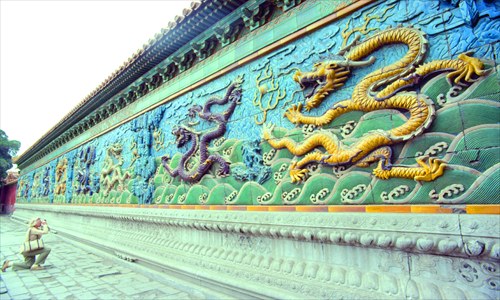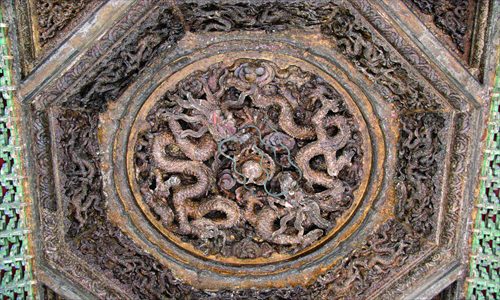

The coming Chinese New Year is the year of the dragon. In Chinese culture the dragon symbolizes courage, fortune, control of nature and imperial authority, a very different image than the one of ferocity that many often associate dragons with. The dragon is an extremely important icon in Chinese culture and can be seen throughout literature, art and architecture. Beijing itself has a rich collection of buildings featuring dragons. Lifestyle presents a few of the most fabulous dragon relics in town.
Jiulong bi (nine dragon wall)
Being the heart of imperial China, it is hardly surprising that there are traces of dragons everywhere in the Forbidden City. From paintings on the ceiling and sculpting on the emperors' chair to embossments on the walls and patterns on the bridge, there are more than 13,000 dragons within its walls. The most famous? Jiulong bi, the nine dragon wall.
The jiulong bi is a unique Chinese screen wall with reliefs of nine different dragons. It was built in 1772 and is located in the inner court of the Forbidden City, at the entrance of the Palace of Tranquil Longevity.
The wall is 20.4 meters long and 3.5 meters high. It is topped with golden glazed tiles to represent the Chinese imperial color. The main part sits on a white marble base, with azure blue and white tiles featuring clouds and water. All the nine dragons on the wall are embossed and pieced together by 270 glazed tiles. The architects choose the number 270 on purpose, as it is a multiple of five and nine, and in Chinese culture five and nine are considered the numbers of ultimate power, symbolizing the authority of the emperor. There are 45 dragon pattern plates under the roof, which is again a multiple of five and nine.
This style of wall can only be found in imperial palaces and gardens. There are three jiulong bi in China in total, one in the Forbidden City, another in Beihai Park, which is also in Beijing, and a final one in Datong, Shanxi Province. The one in Beihai Park is larger than that in the Forbidden City, but also follows its form and design. The one in Shanxi, however, is different from the two in Beijing. Its dragons have four claws, while the dragons in Beijing have five. This is because the number of claws depended on the rank of the jiulong bi's owner. The Shanxi jiulong bi belonged to a prince, who was lower in rank than the emperor.
Long wen (dragon roof sculpture)
If you look up when walking inside the Forbidden City, you will notice many dragon sculptures on the roofs of the ancient buildings. These dragon sculptures are a distinctive part of Chinese traditional architecture. The long wen on the roof of the Hall of Supreme Harmony is the largest one in China. It is 3.4 meters high and 2.6 meters long, with a weight of 3.4 tons. According to legend the dragon once committed grave crimes, and as a result was stabbed in an act of atonement. Consequently, the sculptor designed the dragon to appear like it is biting the roof ridge and rushing to the sky.
The long wen serves a purpose beyond just decoration though. It is believed that the two whiskers on the dragon protect the building against lightning. The long wen also prevents against leaking, as it covers the gap between the roof ridge and wall. What's more, Chinese believe dragons control water, so the long wen is also rumored to make sure a fire never breaks out.
Dragon temple
Historically a dragon temple was very significant for Chinese farmers, since dragons were believed to rule water in Chinese tales. Farmers would pray for rain at the temple during a drought, and they would also celebrate there if they got a good harvest. The dragon temple was thus a place of performance in villages.
There are still many remaining dragon temples around Beijing, including the ones in Xiaweidiancun, Badachu and Sanjiadian, and the most famous one, which is located in Sanjiadian, Mentougou district.
The dragon temple in Sanjiadian was built in the Ming Dynasty (1368-1644), and contains shrines of five dragons in five directions (North, East, South, West and the middle), all representing the five elements of China (metal, wood, water, fire and earth). A pagoda tree was also planted in the temple 500 years ago, which farmers would worship.
In addition, the dragon temple is also famous for its fresco, featuring a parade of dragons with other legendary water creatures from Chinese tales, such as a turtle and a crab.
Where to see dragons in Beijing
Forbidden City
Address: No.4 Jingshan Qianjie, Dongcheng district
Beihai Park
Address: No.1 Wenjin Jie, Xicheng district, take bus 685, get off at Beihai
Shen Long Ancestral Hall
Address: Haidian district, at the northern base of Shou An Mountain, northeast of Beijing Botanical Garden
Long Wang Temple
Address: Mengtougou district, take bus 112, 336 or 941, get off at Sanjiadian
Long Quan Nunnery
Address: Shijingshan district, take bus 347, 958 or 598, get off at Badachu

Copyright ©1999-2011 Chinanews.com. All rights reserved.
Reproduction in whole or in part without permission is prohibited.